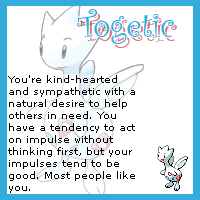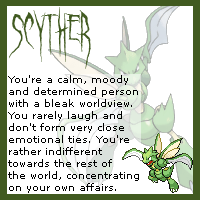Post by pokeria1 on Jul 28, 2009 14:30:47 GMT -5
Well, I've been cruising on Wikipedia looking for info or edits on wikipedia, I stumbled upon something about how Females both completely respect Misty and are influenced by her.
Now, I know that some people either on here or elsewhere will try to claim that the information is completely invalid just because it's from Wikipedia and it can be edited by anyone (It happens all the time), so I also am going to post the sources to ensure that this information is definitely true.
[/URL](Print) 1573-2762 (Online) 0360-0025 (Print) 1573-2762 (Online). [/URL]
17.^ Tobin, Joseph Jay (2004). Pikachu's Global Adventure: The Rise and Fall of Pokémon. Duke University Press. pp. 284. ISBN 0-822-33287-6.[/QUOTE]
As soon as Bulbagarden is back online, I'm going to post this info on wherever certain users are (as long as it's a Misty topic) and prove what we have tried to state all along.
BTW, for anyone on BMGf and/or Serebiiforums, I suggest you post the information on the Misty clubs as well (Be sure to include the sources as well).
[edit] Critical reception
The book The Japanification of Children's Popular Culture described Misty's portrayal in the anime as a mother figure, calling her a "nurturing component" for the original trio of herself, Ash and Brock.[9] It further described her as an "unusually 'complete' girl of the cartoon world", noting both her feminine sentimentality and her "explosive rage".[10] The book Pikachu's Global Adventure: The Rise and Fall of Pokémon stated that the anime focused on Ash, Misty was a distinctly significant character especially to young female consumers, neither "butch" nor "dizzily feminine", seemingly "carefully constructed to appeal to preadolescent girls".[11] It added that unlike other aggressive female characters in the series, Misty did not sacrifice her femininity to succeed, making the character further popular with young American women, a contrast to Japanese children who focused more on the individual Pokémon species to identify with.[12]
In studies on the reactions boys and girls had to the concept of Misty as a heroine in the series, girls accepted it and were eager to associate themselves with the character,[13][14] while boys attempted to belittle her efforts.[13] On the other hand, children of both genders felt the character alongside Brock gave Ash a sense of identity and moral support, which researchers attributed to the concept of group identity.[15] In another study, children were shown to associate the attributes of attractiveness and aggressiveness, while college students described the character as romantic.[16] Pikachu's Global Adventure additionally stated Misty also served as a source of non-threatening sexuality for both older and younger male viewers, though the context of such was presented in a more subtle for North American localizations of the series.[17]
The book The Japanification of Children's Popular Culture described Misty's portrayal in the anime as a mother figure, calling her a "nurturing component" for the original trio of herself, Ash and Brock.[9] It further described her as an "unusually 'complete' girl of the cartoon world", noting both her feminine sentimentality and her "explosive rage".[10] The book Pikachu's Global Adventure: The Rise and Fall of Pokémon stated that the anime focused on Ash, Misty was a distinctly significant character especially to young female consumers, neither "butch" nor "dizzily feminine", seemingly "carefully constructed to appeal to preadolescent girls".[11] It added that unlike other aggressive female characters in the series, Misty did not sacrifice her femininity to succeed, making the character further popular with young American women, a contrast to Japanese children who focused more on the individual Pokémon species to identify with.[12]
In studies on the reactions boys and girls had to the concept of Misty as a heroine in the series, girls accepted it and were eager to associate themselves with the character,[13][14] while boys attempted to belittle her efforts.[13] On the other hand, children of both genders felt the character alongside Brock gave Ash a sense of identity and moral support, which researchers attributed to the concept of group identity.[15] In another study, children were shown to associate the attributes of attractiveness and aggressiveness, while college students described the character as romantic.[16] Pikachu's Global Adventure additionally stated Misty also served as a source of non-threatening sexuality for both older and younger male viewers, though the context of such was presented in a more subtle for North American localizations of the series.[17]
Now, I know that some people either on here or elsewhere will try to claim that the information is completely invalid just because it's from Wikipedia and it can be edited by anyone (It happens all the time), so I also am going to post the sources to ensure that this information is definitely true.
9.^ West, Mark I. (2008). The Japanification of Children's Popular Culture. Rowman & Littlefield. p. 58. ISBN 0810851210.
10.^ West, Mark I. (2008). The Japanification of Children's Popular Culture. Rowman & Littlefield. p. 78. ISBN 0810851210.
11.^ Tobin, Joseph Jay (2004). Pikachu's Global Adventure: The Rise and Fall of Pokémon. Duke University Press. p. 21. ISBN 0-822-33287-6.
12.^ Tobin, Joseph Jay (2004). Pikachu's Global Adventure: The Rise and Fall of Pokémon. Duke University Press. pp. 231-232, 282. ISBN 0-822-33287-6.
13.^ a b Tobin, Joseph Jay (2004). Pikachu's Global Adventure: The Rise and Fall of Pokémon. Duke University Press. p. 176. ISBN 0-822-33287-6.
14.^ Katch, Jane (2004). They Don't Like Me: Lessons on Bullying and Teasing from a Preschool Classroom. Beacon Press. ISBN 0807023213.
15.^ Tobin, Joseph Jay (2004). Pikachu's Global Adventure: The Rise and Fall of Pokémon. Duke University Press. pp. 169-170, 177. ISBN 0-822-33287-6.
16.^ Ogletree, Shirley M.; Cristal N. Martinez, Trent R. Turner and Brad Mason (2004). "Pokémon: Exploring the Role of Gender". Sex Roles (Springer Netherlands) 50, Numbers 11-12 / June, 2004: 851-859. doi:10.1023/B:SERS.0000029102.66384.a2. ISSN [URL="http://www.worldcat.org/issn/0360-0025
10.^ West, Mark I. (2008). The Japanification of Children's Popular Culture. Rowman & Littlefield. p. 78. ISBN 0810851210.
11.^ Tobin, Joseph Jay (2004). Pikachu's Global Adventure: The Rise and Fall of Pokémon. Duke University Press. p. 21. ISBN 0-822-33287-6.
12.^ Tobin, Joseph Jay (2004). Pikachu's Global Adventure: The Rise and Fall of Pokémon. Duke University Press. pp. 231-232, 282. ISBN 0-822-33287-6.
13.^ a b Tobin, Joseph Jay (2004). Pikachu's Global Adventure: The Rise and Fall of Pokémon. Duke University Press. p. 176. ISBN 0-822-33287-6.
14.^ Katch, Jane (2004). They Don't Like Me: Lessons on Bullying and Teasing from a Preschool Classroom. Beacon Press. ISBN 0807023213.
15.^ Tobin, Joseph Jay (2004). Pikachu's Global Adventure: The Rise and Fall of Pokémon. Duke University Press. pp. 169-170, 177. ISBN 0-822-33287-6.
16.^ Ogletree, Shirley M.; Cristal N. Martinez, Trent R. Turner and Brad Mason (2004). "Pokémon: Exploring the Role of Gender". Sex Roles (Springer Netherlands) 50, Numbers 11-12 / June, 2004: 851-859. doi:10.1023/B:SERS.0000029102.66384.a2. ISSN [URL="http://www.worldcat.org/issn/0360-0025
17.^ Tobin, Joseph Jay (2004). Pikachu's Global Adventure: The Rise and Fall of Pokémon. Duke University Press. pp. 284. ISBN 0-822-33287-6.[/QUOTE]
As soon as Bulbagarden is back online, I'm going to post this info on wherever certain users are (as long as it's a Misty topic) and prove what we have tried to state all along.
BTW, for anyone on BMGf and/or Serebiiforums, I suggest you post the information on the Misty clubs as well (Be sure to include the sources as well).


 (Now nonexistent)
(Now nonexistent)



 [url=http://www.dragonflycave.com
[url=http://www.dragonflycave.com  [/url]
[/url]
